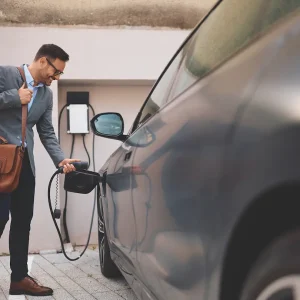Vauxhall’s push into the future fleet arena is an electric vehicle with a twist. Paul Barker finds out more from GM’s man tasked with launching EVs in Europe
Vauxhall‘s version of the future of fleet is an electric vehicle that offers an answer to what the firm brands the “range anxiety” of electric vehicles.
The design of the Ampera, which will be with us within two years, has already been revealed. However, BusinessCar was recently invited into General Motors’ test facility in Bedfordshire to drive a development prototype of the revolutionary model, with the running gear slotted under the body of a lower medium Cruze from Vauxhall’s sister firm Chevrolet.
The Ampera is so new, exciting and different because, unlike electric vehicles being developed by the company’s rivals, Vauxhall’s alternative is an EV with a range of just under 40 miles on the battery, before a 1.4-litre petrol engine chips in to power the electric motor. Vauxhall calls it a range extender system.
“The customer is only interested in one issue – mobility,” GM director of EV implementation Gherardo Corsini tells BusinessCar. “With electric vehicles the range challenge is critical because it risks mobility.”
Key to the Ampera is the petrol engine, which is a version of the 1.4 already used in the Corsa and Astra models but tuned for “steady-stage” driving. Rather than actually powering the wheels, the unit powers the electric motor that then provides propulsion. The engine doesn’t recharge the battery, it purely chips in to move the vehicle when the electric charge has diminished. “We are trying to use the flexibility of plug-in hybrids and electric vehicles, but not burden our car with range anxiety or a dependence on petroleum,” says Corsini. “Even if the range is seldom reached, on an EV it is a psychological issue.”
“It costs 80p to charge the car through a normal electric plug-in; the cost is five or six times higher to recharge using the petrol engine because fuel costs are higher than electric costs,” says Corsini. “The main purpose of this car is that it should be driven with electricity from the grid as it is five or six times cheaper than petrol.”
Corsini echoes the words of other car makers who claim range is something of a red herring for most drivers. He claims regular petrol and diesel cars aren’t generally driven for more than 30 miles per day for commuting to and from work, or heading out on local domestic trips. However, he points out that the Ampera can run on petrol power for the irregular longer journeys such as holidays without needing a stop every 50 miles or so for a battery recharge, although a fuel economy figure has yet to be quoted for running the car on petrol power alone.
“This is not a car for salesmen on the road all the time,” says Corsini. “I hope they will buy a diesel Insignia!” But generally, GM is hoping people will be able to use the Ampera as an everyday first car, instead of the second or family car most electric vehicles are destined to be, at least until a nationwide fast-charge network is established.”
Cost
The question of expense, both in purchasing and whole-life cost terms, is still a slightly thorny one.
“It’s too early to discuss a price, although we won’t get it to the same price as an Astra,” says Corsini. “But affordability is a very important issue.” He wouldn’t be drawn on the subject of a list price, but industry rumours have suggested it could be around the £25,000-£30,000 area. “It’s difficult two years out. We need to see where the competition will be and we need to be able to communicate to the customers what they can save,” says Corsini. “And do we get incentives? At the beginning it will really make a difference. There are too many unknowns that prevent us from having a clear picture.”
The issue of Government help to establish an EV market is another awkward topic. Labour has promised a £5000 per car grant from 2012, and a five-year benefit-in-kind tax exemption for drivers, but the details are yet to be thrashed out so it can’t be assumed that an electric vehicle using a petrol engine for assistance would be eligible. “For us this is an electric vehicle. If you never use the range extender it is always an electric vehicle,” says Corsini, who adds that he hopes for grants based on ultra-low-CO2 vehicles, not aimed at specific technology.
But Corsini did praise the UK for its EV stance. “There are only a few countries that are advanced in terms of electric mobility and the UK is one of them,” he says. “The UK is focussed on creating a mechanism for support that’s at least two-fold – one through direct subsidy and two through political signals.”
GM Europe is still assessing how best to sell the Ampera, whether to lease, sell out-right or combine the two. “There is no wrong system. Everything that helps us deliver EVs is a good system,” he says. And though the UK’s unique company car-orientated new car market could provoke special attention, “we need a very visible and transparent system throughout Europe, and market-specific requirements will have complications.”
The whole-life cost issue is clouded by confusion over residual values and servicing.
“We are analysing the RV impact of EVs, but we don’t have a starting point,” says Corsini, while service intervals could be longer as there are less mechanical parts compared to a traditional internal combustion engine. “We have a clear idea of how to service it,” adds Corsini, “but it will require training and a focus away from mechanical and into electronics.”
These are just some of the issues that will have to be ironed out in the next 24 months or so, as the car that could be the missing link between petrol and electric power makes its way onto the market, with the early-adopting and more savvy fleet sector first in its sights.





